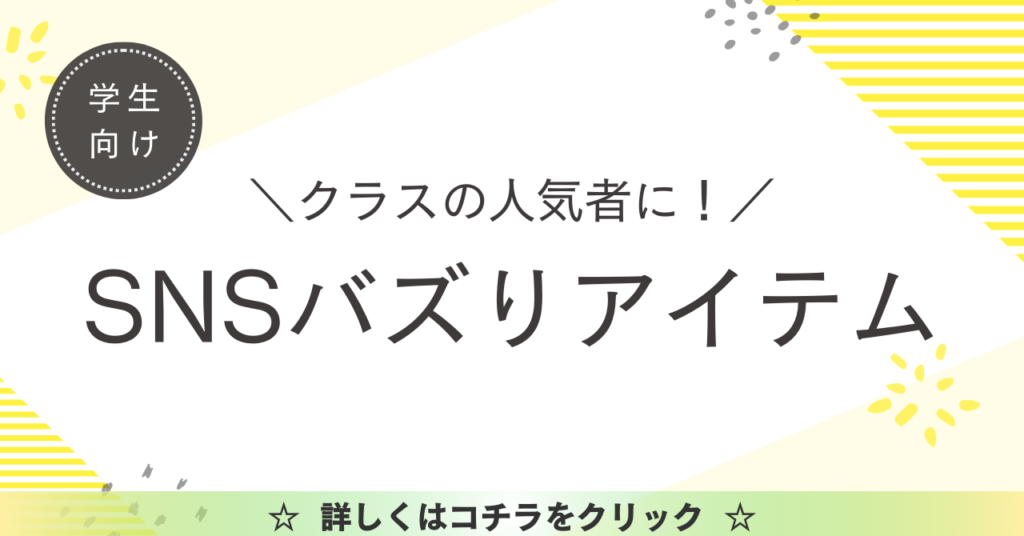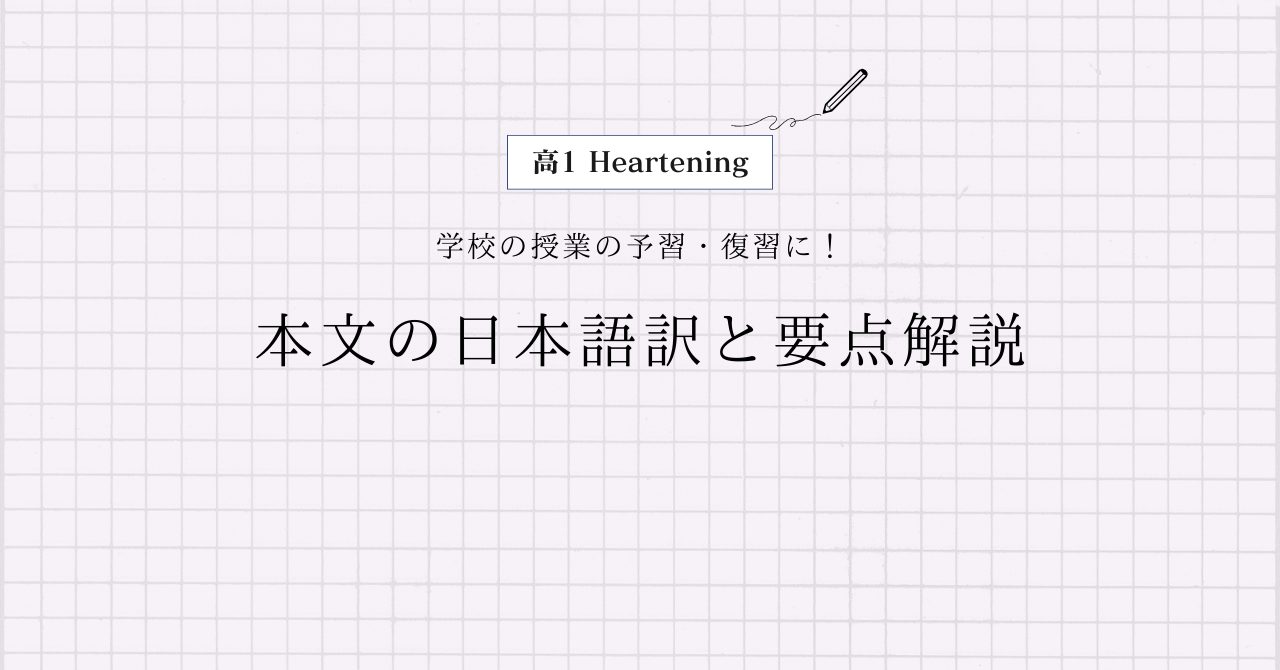桐原書店 高1Heartening Lesson5 Section4の本文の日本語訳と重要箇所の解説です。
Lesson5-1, 5-2, 5-3の解説はこちらからご覧ください。
>高1Heartening Lesson5 Section1 本文和訳
>高1Heartening Lesson5 Section2 本文和訳
>高1Heartening Lesson5 Section3 本文和訳
- Heartening Lesson5 Section4 本文と日本語訳
- Heartening Lesson5 Section4 重要事項の解説
- Akimoto came up with a new idea.
- It works like this.
- The canned bread has a shelf life of three years.
- Purchasers of canned bread receive a replacement set a year before the best-before date and return their old cans of bread.
- Then the old cans are sent overseas to assist people in need, instead of going to waste.
- This system works well for everyone: Akimoto, the customers who donate canned bread, and the people who eat it.
- With this system, the Kyu-Can-Cho Project started in 2009.
- Since then, it has delivered 270,000 cans to feed disaster victims and starving people in many countries.
- Akimoto has personally delivered canned bread to people overseas.
- Children’s faces light up with delight as they eat it.
- “It is so rewarding to bring a moment of happiness to a hungry person,” he says.
- “It makes me feel proud.”
- Heartening Lesson5 Section4 まとめ
Heartening Lesson5 Section4 本文と日本語訳
Akimoto came up with a new idea.
「秋元さんは新しいアイディアを思いつきました。」
It works like this.
「それはこのように機能しています。」
The canned bread has a shelf life of three years.
「缶詰パンの保存可能期間は3年です。」
Purchasers of canned bread receive a replacement set a year before the best-before date and return their old cans of bread.
「缶詰パンの購入者は、賞味期限の1年前に交換品のセットを受け取り、古いパンの缶詰は返却します。」
Then the old cans are sent overseas to assist people in need, instead of going to waste.
「その後、古い缶詰は無駄にはならずに、困っている人々を助けるために海外に送られます。」
This system works well for everyone: Akimoto, the customers who donate canned bread, and the people who eat it.
「このシステムは、秋元さん、缶詰パンを寄付するお客、そしてそれを食べる人と、あらゆる人にとってうまく機能しています。」
With this system, the Kyu-Can-Cho Project started in 2009.
「このシステムを用いた、救缶鳥プロジェクトが2009年に始まりました。」
Since then, it has delivered 270,000 cans to feed disaster victims and starving people in many countries.
「それ以来、救缶鳥プロジェクトは多くの国の災害の被災者や飢えに苦しむ人々に食料を供給するために、27万個の缶詰を配達しています。」
Akimoto has personally delivered canned bread to people overseas.
「秋元さんは個人的に、海外の人に缶詰パンを配達しています。」
Children’s faces light up with delight as they eat it.
「子どもたちがそれを食べると、彼らの顔は喜びで明るくなります。」
“It is so rewarding to bring a moment of happiness to a hungry person,” he says.
「『お腹が空いた人に幸せの瞬間を届けることはとてもやりがいがあります。』と彼は言います。」
“It makes me feel proud.”
『それは私に誇りを感じさせてくれるのです。』

Heartening Lesson5 Section4 重要事項の解説
Akimoto came up with a new idea.
“come up with~”は「を思いつく」という重要表現です。
It works like this.
“It”は“a new idea”を指していますね。
“work”は「機能する、効果がある」といった動詞で、“like”は「~のような」という前置詞です。
The canned bread has a shelf life of three years.
“can”は「を缶詰にする」という動詞で、ここでは「過去分詞」として後ろの“bread”を修飾しています。
“shelf life”は「保存可能期間」といった名詞ですね。
“of”は前置詞で,”A of B”の形で「BのA」というように後ろから前に訳します。
Purchasers of canned bread receive a replacement set a year before the best-before date and return their old cans of bread.
“purchaser”は「購入者」、“replacement”は「交換(品)、代替(品)」、“set”は「セット、一式」といった名詞になります。
“of”は後ろから前に訳しましたね。“receive”は「を受け取る」という動詞です。
“a year before~”は「~の1年前」となり、“best-before date”は「賞味期限」という名詞になります。
“return”は「を返却する、戻す」といった動詞で、“their”は“purchaser”を指しています。
“can”は「缶詰」という名詞ですね。
Then the old cans are sent overseas to assist people in need, instead of going to waste.
“then”は「それから、その後」、“overseas”は「海外に・へ」という副詞です。
“sent”は“send(を送る)”の過去分詞形で、ここでは「受動態」になっていますね。
“assist”は「を手助けする」といった動詞で、ここでは“to”が付いて「不定詞の副詞的用法」になっています。
“in need”は「困っている」、“instead of~”は「~の代わりに、~しないで」といった重要表現です。
“go to waste”は「無駄になる」という意味で、前置詞“of”の後ろなので“going”は「動名詞」になっていますね。
This system works well for everyone: Akimoto, the customers who donate canned bread, and the people who eat it.
“system”は「システム」、“everyone”は「みんな、誰でも」といった名詞、“work well”は「上手く行く」といった表現、“for”は「~にとって」という前置詞です。
「:」は「コロン」と言い,簡単に言うと「つまり」という具合に直前の文章を補足します。コロンを使うときは,コロンの前は必ず文にしないといけない点に注意してください。
“customer”は「客」という名詞、“who”は「主格の関係代名詞」で、“who donate canned bread”が先行詞“the customers”を修飾していますね。
“donate”は「を寄付する、提供する」という動詞です。
“who eat it”も「主格の関係代名詞」で、先行詞“the people”を修飾しています。“it”は“canned bread”を指していますね。
また,3つ以上の単語を“and”で繋げたいときは,最後の単語の前に”and”を置いて,それ以外はカンマ(,)で繋ぎます。
例えばA, B, C, Dの4つを並べるときは,“A, B, C and D”としてあげます。“and”の前にカンマを入れてもOKです。
With this system, the Kyu-Can-Cho Project started in 2009.
“with”は前置詞で「~と一緒に」と訳すことが多いですが,必ずしも後ろに人が来るわけではありません。イメージとして「~とセットで」と覚えておきましょう。
“Kyu-Can-Cho Project”は「救缶鳥プロジェクト」です。
Since then, it has delivered 270,000 cans to feed disaster victims and starving people in many countries.
“since then”は「それ以来」という表現です。“it”は“the Kyu-Can-Cho Project“を指しています。
“deliver”は「を配達する、届ける」という動詞で、ここでは「現在完了の継続用法」が使われていますね。
“feed”は「に食料を与える・供給する」といった動詞で、“to”が付いて「不定詞の副詞的用法」になっています。
“disaster”は「災害」、“victim”は「被災者、犠牲者」という名詞、“starving”は「飢えている」という形容詞です。
Akimoto has personally delivered canned bread to people overseas.
ここでも「現在完了」が使われていますね。
“personally”は「個人的に」という副詞です。
Children’s faces light up with delight as they eat it.
名詞に‘sを付けると「~の」という所有を表します。
直前の名詞が複数形のときは” teachers‘ “のようにアポストロフィーだけを最後に付けます。
“light up with delight”は「喜びで明るくなる」という表現です。
この“as”は「~するとき」という接続詞です。接続詞“as”は5つの意味があるので、文脈に応じて訳を考えないといけません。以下に“as”の意味をまとめておきます。
“they”は“Children”を、“it”は“canned bread”を指していますね。
“It is so rewarding to bring a moment of happiness to a hungry person,” he says.
ここでは「it to構文」が使われていますね。
“It”は形式主語で、真の主語は“to bring a moment of happiness to a hungry person”です。
“so”は「とても」という副詞、“rewarding”は「やりがいがある」といった形容詞になります。
“bring”は「をもたらす、持ってくる」という動詞で、“moment”は「瞬間」、“happiness”は「幸福、幸せ」という名詞です。
“It makes me feel proud.”
“It”は直前の文を指していますね。
“make 人・もの 動詞の原形”で「人・ものに~させる」という使役の意味になります。
“feel”は「感じる」という動詞で、“proud”は「誇りに思う」といった形容詞です。
Heartening Lesson5 Section4 まとめ
以上がHeartening Lesson5 Section4の日本語訳となります。
>高1Heartening Lesson5 Section1 本文和訳
>高1Heartening Lesson5 Section2 本文和訳
>高1Heartening Lesson5 Section3 本文和訳
何か分からない点や他に解説してほしい点があれば,お気軽にコメントしてください!


コメント